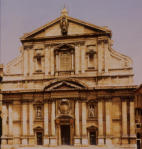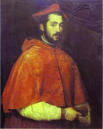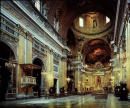|
|
 |
|
The Jesuits: Il Gesu and Sant'Ignazio as Triumphant Churches |
|
written
by hlc / 09.16.2004 |
|
|
|
The Church of Il Gesu |
| |
Patron |
| |
| |

|
| www.univ-tours.fr/.../ Gesu%20Vignole/Facade.jpg |
| Facade of Il Gesu |
|
| |
|
| |

|
| www.abcgallery.com/ T/titian/titian47.html |
| Portrait of Cardinal Alessandro Farnese |
| Farnese was the main patron of Il Gesu. |
| |
|
The full name of Il Gesu is Santissimo Nome di Gesu, meaning, the Most Holy Name of Jesus. Construction of Il Gesu began in 1568 and the church was consecrated in 1584. It is the main and first Jesuit church in Rome (the “mother church” of the Jesuits), and served as an architectural pattern for Jesuit churches that were set up throughout Europe during the Counter Reformation and Baroque period. The church occupies the site St. Ignatius chose for his headquarters of the Society of Jesus. Ignatius placed a great deal of emphasis on the location of churches; Il Gesu is in the heart of downtown which is a very visible and accessible location.
Cardinal Alessandro Farnese, nephew of Pope Paul III, was the major benefactor of the church. His name is predominately displayed across the façade and in various locations inside the church. Farnese was said to have owned the three most beautiful objects in Rome: his family palace (Palazzo Farnese), Il Gesu, and his daughter. He intended the decoration of Il Gesu to be as important as the architecture and wanted the paintings, architecture, and sculpture to be conceived as one unit.
|
| |
|
| |
|
| |
Church Layout / Interior Decoration |
| |
| |

|
| www.arch.montana.edu/.../ Il%20Gesu%20Plan.jpg |
| Plan of Il Gesu |
|
| |
|
| |

|
| www.usc.edu/.../comm544/ library/images/033bg.jpg |
| Interior of Il Gesu |
| The altar is the main focal point of this church. |
| |
|
Il Gesu has a single aisle-less nave with short transepts, a shallow apse, and is flanked by side chapels; there is an emphasis on, and use of wide open space. The focus is set on the high altar which is visible from all parts of the church. The layout of Il Gesu suggests the Jesuit Church’s two major goals: a large nave with side pulpits for preaching to great crowds (sermons were very important), and a main alter as the centerpiece for the celebration of mass.
The interior decoration of the church employs grand opulence and colors which are in keeping with the Jesuit goal of attracting worshippers by grand spectacle. Since this church is built in honor of Jesus, his name is predominantly incorporated throughout the church decoration. The idea of Baroque theatricality is also prevalent, with dramatic and showy decorations. The theatricality would have been enhanced during the 16th century with religious music playing and incense burning, thereby employing multiple senses, and enhancing the spiritual effect of the church.
The interior of the original Il Gesu, however, was vastly different than that which we see today. The nave and barrel vault were white washed, and the decorations simple. Not until almost a century later, when the Jesuits had accumulated more patrons, is much of the decoration done.
|
| |
|
| |
|
| |
Adoration in the Name of Jesus |
| |
| |

|
| www.nuovorinascimento.org/.../ programma.htm |
| Portrait of Baciccio |
| He designed and executed the nave painting in Il Gesu. |
| |
|
| |

|
| www.romeartlover.it/ Ceiling.html |
| "Adoration in the Name of Jesus" fresco |
| The illusion Baciccio created does not photograph well, but is amazing in real-life. |
| |
|
The ceiling painting of the nave, entitled "Adoration in the Name of Jesus," was done by Giovanni Battista Gaulli, otherwise known as Baciccio (1639-1709). Baciccio became a protégé of Bernini, and was recommended by Bernini to paint Il Gesu. He was famous for his use of perspective to create illusion and received many commissions from the church throughout his life. The majority of the decoration in Il Gesu was done by Baciccio, including the nave ceiling, the dome, the half dome, and the stucco figures. He began the nave fresco in 1676, almost a century after the church was completed, and finished three years later in1679.
In the painting Baciccio represented Jesus as a barely visible monogram, IHS (the abbreviation of the Greek form of the name Jesus). The letters emit a blinding light that floats heavenward. In contrast, sinners and heretics are violently thrown back down to Earth. Baciccio painted many of the sinners on three-dimensional stucco extensions which project outside of the painting’s frame to exaggerate the illusion. The nave fresco celebrates the name of the society with its focus on, and adoration of Jesus.
The painting seems to break through the vault and open up a hole in the ceiling – a window to heaven. This incorporated the drama and magnificence that the church was looking for, and created the feeling of being in a spiritual realm. Again, the church is using extravagance and splendor as propaganda to attract followers.
|
| |
|
| |
|
|
 |
|






